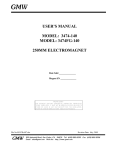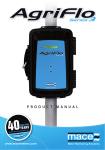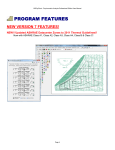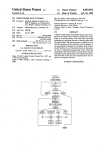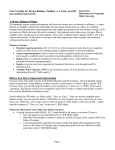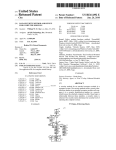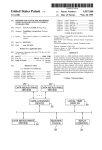Download ESL-IE-10-05
Transcript
ESL-IE-10-05-03 K.A. “Bud” Leavell Practical Solar Thermal Chilled Water Sales Engineer Yazaki Energy Systems Inc. ABSTRACT With the pressing need for the United States to reduce our dependence upon fossil fuels, it has become a national priority to develop technologies that allow practical use of renewable energy sources. One such energy source is sunlight. It has the potential to impact America’s use of non-renewable energy beyond its own design capacity by applying it to the optimization of an existing building’s system. Solar-thermal chilling systems are not new. However, few of them can be described as a practical success. The primary reason for these disappointments is a misunderstanding of solar energy dynamics by air conditioning designers; combined with a similar misunderstanding by solar engineers of how thermally driven chillers react to the loads and energy sources applied to them. With this in mind, a modeling tool has been developed which provides the flexibility to apply a strategy which can be termed, “Optimization by Design”. THE CURRENT STATE OF SOLAR THERMAL CHILLING SYSTEMS IN THE US. As of January 2010, there are about 22 solar thermal chilling systems installed in North America. Of these, only a handful can be said to be providing a useful function. The majority are in place for research, or as a showcase, while never realizing system potential. Yet the interest in the possibilities of this technology is growing rapidly. The simple prospect of having the sun do for free what we have traditionally paid hard cash for is very compelling. Add to that, the changing political climate, driving State and Federal Governments to offer cash and tax incentives and now the demand for engineers to evaluate the potential of this technology in various applications is tremendous. If the technology can be made practical, especially from a financial point of view, the impact can be significant. So what is wrong with those few systems installed in North America? If we are going to make these systems practical, it is imperative that we understand what motivated the installation, how it was designed and implemented and why certain design practices were followed, especially on those less successful systems. What was discovered from an examination of many of these systems was a disconnect between Plano, Texas the two different disciplines involved in this technology. While air conditioning designers were competent and comfortable with hydronic cooling, plumbing, building loads and chilled water in general, they seem to have a misunderstanding of solar energy dynamics. When combined with a similar misunderstanding by solar engineers of how thermally driven chillers react to the loads and energy sources applied to them, you have the recipe for a very expensive system incapable of performing satisfactorily. Among the issues observed have been grossly underpowered systems, inadequate and incorrect control strategies, and a lack of critical safety devices. Another obvious shortcoming was the application of too small an amount of common sense, and an inaccurate understanding of the technology. Solar Thermal is one area of engineering which is rife with misinformation, yet there is a wealth of accurate information available on the internet for free. It comes from reputable sources including the US Government and third party product evaluation laboratories, not to mention some very good texts. Today there is no reason for a system to be designed in the United States based on other than empirical data. As an example, the most common problem observed in these systems is their lack of adequate solar energy. The explanation for this turned out to be very simple, it is caused by the disconnect between air conditioning disciplines and solar thermal disciplines. Traditionally, the solar thermal guys have used integrated daily solar energy values, which are themselves derived from averages of averages. They also calculate the loads they intend to service in the same way. And for simple loads like domestic hot water, this seems to be adequate. On the other hand, air conditioning loads are very difficult to average over a day, much less over a longer period of time. So how do you adequately match the load with the energy source? Following these methods, you are bound to find yourself under powered. Looking at it from the other side, the air conditioning engineer designs for extremes, also termed “design conditions”. When designing a chilled water system to meet the 1% design condition, which is the only logical way to insure that the load is met satisfactorily, you may still lack the data needed to determine how much solar energy is available during those extremes. Once again, the system ends up grossly underpowered. So far, only one of the Proceedings from the Thirty-second Industrial Energy Technology Conference, New Orleans, LA, May 19-22, 2010. ESL-IE-10-05-03 One other issue which has contributed to this shortfall of energy is the application of the absorption process to solar thermal energy. Even if we adequately determine the load, and accurately estimate the energy available over the course of an average of average days, we are likely to find the chiller short of power. Simply because an absorption chiller’s Coefficient of Performance is affected by both the temperature of the heat medium, (the energy source) and the temperature of the cooling water (the condenser loop). If we size based on the daily average load and the daily average solar energy, we will find that the energy available around noon is greater than the energy demand of the chiller. This results in the heat medium fluid temperature in the buffer tank increasing. This is what we want. Store the energy for use later. The only trouble is, the increased temperature in the tank, increases the amount of work the chiller can perform, while at the same time reducing the COP of the chiller. Later in the afternoon as the solar energy is decreasing and the building load is increasing, the engineer discovers too late that he has less energy stored than he thought. The result is an inadequately powered chiller when you need it the most. So how do we remedy these shortcomings? Utilizing a recently developed modeling template in a step by step process, the engineer can adequately size the energy source and buffer storage, position the collector array for best performance and evaluate the predicted output, including the financial benefits of the application. STEP 1. EXPLICITY DEFINE THE EXPECTATION. We need to start with a clear definition of what we expect the sun to do for us. There are a lot of opportunities for increasing the energy efficiency of a building HVAC system. Solar provides a lot of possibilities limited only by the engineer’s imagination and the economics of the individual application. In looking for the place where we can have the most effect, the low hanging fruit would be those applications where we can get more savings out of the investment, than the capacity of the invested system. If we can find a way to get greater than 40% reduction in electric use, by correctly applying solar energy to 25% of the load, then we will have achieved an exponential savings. This is possible in at least two scenarios where the physics of an existing process is optimized by strategically applying the energy from the sun. Since many commercial buildings have existing chilled water systems, and since virtually all chillers have a COP (Coefficient of Performance) which improves as the load on the system decreases, then we have an opportunity to use solar energy in a peak shaving configuration to gain just such savings. Figure 1 is a graph of the power curve of a popular water cooled screw chiller. A close examination shows that if we can keep this screw chiller running between 25% and 75% of full capacity then the electric demand per ton of chilled water is at its most advantageous point. Part Load Performance For Chiller Type: 0.800 kWatts per Refrigerant Ton systems evaluated seems to be over-powered, and only one system appears to be adequately powered that is still operating. And it is a derated system. 0.700 0.600 0.500 0.400 0.300 0.200 0.100 0.000 0% 10% 20% 30% 40% 50% 60% 70% 80% 90% 100% Percent of Full Load Figure 1 Figure 2 illustrates the financial effect of part load operation on this same chiller. Notice that at 100% capacity, the COP is 4.88. So for every 1 kW of electric energy applied, the chiller does 4.88kW of work. This is actually quite good. But reduce the load to 75% of capacity and that COP increases by another 21%. So the expectation for this example application will be to keep this existing screw chiller from exceeding 75% of full capacity while the sun is shining. This will provide an absolute reduction in power required to air condition the building during the peak period of about 25%. Plus, we will realize an additional savings for the remaining portion of the load through the increased COP of the chiller. It should not be unexpected to realize an electric consumption reduction of over 40% during these peak periods. The method we will use is a sidestream configuration where the solar driven absorption chiller is pre-cooling a portion of the return chilled water. By reducing the temperature of the chilled water returning to the electric chiller, it will then unload as the solar system is reducing the work it is expected to do. See figure 3. Proceedings from the Thirty-second Industrial Energy Technology Conference, New Orleans, LA, May 19-22, 2010. ESL-IE-10-05-03 the heat production of the collector(s). The wet bulb temperature is required not only for sizing the cooling tower, but also for estimating the temperature of the water leaving the tower as this affects both the chilled water output and the volume of heat input to the chiller. Figure 2 Figure 3. Anytime the load is smaller than 25% of the electric chillers full capacity, and the sun is shining, we can completely stop the electric chiller. The VFD (Variable Frequency Drive), in the chilled water loop must have a lower limit of the flow rate for the absorption chiller and a maximum rate of 100% of the load capacity. It is far better to size a solar array for a chilled water system by using hourly solar and meteorological data than attempting to use daily integrated values. There are several weaknesses with the daily data. The first is knowing how many hours per day the integrated data covers. Even if you know how many hours it covers, that doesn’t guarantee that your collector array will be able to collect heat for the entire period. It probably cannot - due to the angle of the sunlight to the collector aperture. So, how can you then estimate the average hourly solar intensity since the total daily amount available is in question. Secondly, it is impossible to get a single dry bulb temperature and solar intensity that adequately represents the average value during the entire day. You will inevitably get one or both values such that you are either overestimating or underestimating the output of the collector. The observed tendency is that the output of the collector array is overestimated resulting in many of the existing North American solar chillers being grossly underpowered. If on the other hand, you use hourly data, the anticipated load on the chiller during a given time period may be compared to the expected heat output from the collectors during that same period. This will allow for a more precise method of sizing the collector array and buffer storage tank. Another advantage to this type of configuration is in the capital cost savings. Since the building already has an airside system with chilled water, we can ignore that portion of the system when calculating the costs. And there is no need to supply a back-up heat source for when the sun is bashful or sleeping, since the building is already equipped with a chilled water system sized for 100% capacity. Calculating collector output is one area that is rife with misinformation. There is much oversimplification in the marketing materials of some equipment manufacturers that lead the engineer to make performance calculations based on solar and meteorological conditions which do not exist in the real world. This of course is completely unnecessary as data describing real world conditions in the United States is readily available. STEP2. HOW MUCH SUN DO WE HAVE? There are a number of factors affecting the intensity and duration of solar radiation available to power our system. Among these factors are latitude, air pollution (especially ozone and particulates), atmospheric moisture content, cloud cover, frequency and duration of precipitation. Other factors which must be considered are the ambient dry bulb and wet bulb temperatures. The intensity of the solar radiation and the dry bulb temperature are required to estimate The source for this hourly data in the United States and its territories is the National Solar Radiation Database. If you are outside of the US or its territories and your government does not have this data available, you will need to model it from the daily average data available from NASA. Don’t forget that you need solar irradiance, plus dry bulb and wet bulb. Often when using data from somewhere other than the National Solar Radiation Database you will only get the data in 3 hour Proceedings from the Thirty-second Industrial Energy Technology Conference, New Orleans, LA, May 19-22, 2010. ESL-IE-10-05-03 averages. You will need to interpolate this data in order to get a reasonable approximation of the actual hourly conditions. And if you are modeling your own data, you must differentiate between “Direct” or Beam” radiation, and diffuse. Normally, this daily data is described as Global Normal, or Global Means. This is a combination of Beam and Diffuse and you will have to separate them. The data from the NSRDB is already broken out as Global Means and Diffuse. Beam radiation is then calculated by subtracting diffuse from global. We will also want to download some daily integrated data from NASA. We will use this for the purpose of determining the most advantageous initial tilt angle for the collector array. To retrieve this data, visit: http://eosweb.larc.nasa.gov/sse/ Tilt of the collector is defined as that angle from the ground to the collector on the side of the collector away from the equator, (figure 4). The National Renewable Energy Labs has been collecting solar and meteorological data since 1961. It covers approximately 1440 locations within the US and its territories. A portion of those locations are actually measured data. The remaining locations are modeled based on the measured data. We are interested in both the Hourly Statistical Summaries which show the hourly average insolation, and the Typical Meteorological Year data. This data may be accessed for free from: http://rredc.nrel.gov/solar/old_data/nsrdb/ The Hourly Statistical Summaries will provide a monthly average of solar energy falling on a horizontal plane in Watts per square meter for the hour ending at the indicated time. So for January, the 1300 hours data will be the average of every day in January of the irradiance falling on the ground between 1200 hours and 1300 hours in Watt hours per square meter. This data is given for global horizontal, horizontal diffuse, and direct or beam radiation. This data is also available for each of 15 years. You should download all 15 years and then average them. The modeling template will do the averaging for you. Typical Meteorological Year data (TMY3 files) provides multiple measurements on an hourly basis for both the sunlight and the meteorological data. It is based on a 30 year period of time, and chooses for each month, that month from the 30 year period of time that is statistically the most typical. You are likely to find that you have a different year chosen for each of the 12 months of the “Typical Meteorological Year”. Since there are differences from one year to the next, some smoothing is done on the transition days between these months. The modeling template will give you a choice of using either the 15 year average or the TMY3 data for the solar energy, and goes to the TMY3 data for all dry bulb and relative humidity values. Figure 4. Tilt angle can have a profound effect on the amount of energy delivered to the aperture surface of the collector. The data which we will be using is that sunlight which is falling on the horizontal surface of the ground. Tilting the collector to the point where it is normal to the sun (perpendicular to the sun’s rays) will increase the amount of sunlight to which the collector aperture area is exposed. Figure 5 illustrates the difference. In the case that the collector is normal to the sun, we take the amount of sunlight falling on a horizontal surface, Ih and divide it by the cosine of the solar zenith angle θz. The collector will rarely be normal to the sun. So any angle of incidence that the sun has to the collector will have a similar but opposite effect. In that case, we will now calculate the actual sunlight by first multiplying the horizontal radiation by the cosine of the solar angle of incidence to the collector θ, and then dividing by the cosine of the solar zenith angle θz. All of this is done automatically in the modeling template. Proceedings from the Thirty-second Industrial Energy Technology Conference, New Orleans, LA, May 19-22, 2010. ESL-IE-10-05-03 I = Ih × cos θ / cos θz Equation (1) where: I = insolation on the tilted collector Ih = insolation on the horizontal surface Θ = solar angle of incidence to the collector Θz = solar zenith angle Figure 5. Now examining a graph of the daily integrated data from NASA, figure 6 presented as the Insolation on a collector at 4 different tilt angles, we can determine the best starting tilt angle for our application. Figure 6. We see that the line representing a tilt of 18° or Latitude - 15° provides us the best overall starting tilt angle for an application that is more interested in air conditioning during the months April through September than any other angle. If on the other hand, our application was for dehumidification and we needed to accomplish that during the winter months as well as the summer months, we might opt for Latitude + 15° instead. Overall, in North America, Latitude - 15° seems to work best for air conditioning. This is the only use we will make of daily integrated values of solar data. Everything else will be done with hourly data. STEP 3. WHAT TYPE OF COLLECTOR? Now we need to select the most appropriate collector for our application. The key here is remaining focused on the application. This modeling tool recognizes only 2 types of collectors. Those are the flat panel and evacuated tube collectors. Since this tool is designed around single effect low temperature water fired chillers, high heat medium temperatures are not required. What is required is a high volume of heat. For instance, a 30 Refrigerant Ton Chiller at rated conditions will require 512MBtuh input hot water to produce 30 Refrigerant Tons. It will in fact produce greater than 30 Refrigerant Tons if the heat input is increased. With this in mind, we need to find the most cost effective way to get heat into the chiller when it is required or can be utilized. The primary differences between flat panel and evacuated tube collectors lies in their loss profile, ratio of aperture area to gross area, and incidence angle modifier. The choice of one type of collector over the other is dependent on multiple factors. Cost is always one of them. Perhaps available roof space, or the existence of large quantities of snow should be considered. The application’s needs must be paramount. If the collector array choice brings more negatives than it does positives, then the system implemented could easily turn out useless. There are two variables which primarily affect the efficiency of these collectors. The 1st and greatest effect is the temperature difference between the outdoor ambient and the average temperature of the heat medium fluid in the collector. The greater this ∆T is, the greater the thermal energy losses, and the lower the efficiency of the collector. Evacuated tubes have a significant advantage here, as they essentially have the heat collection medium sealed up in a thermos bottle. But, this can turn into a serious disadvantage in locations with a large amount of snow. Due to their inherently low losses, it is very easy for evacuated tubes to be rendered useless by snow cover. On the other hand, the losses of flat panel collectors can effectively keep the snow cleared away, providing solar contribution when evacuated tubes would be buried in the snow. Evacuated tubes Proceedings from the Thirty-second Industrial Energy Technology Conference, New Orleans, LA, May 19-22, 2010. ESL-IE-10-05-03 are most often designed using heat pipe technology. This brings the advantage of lower losses through emission, but also forces them into a minimum tilt angle, which may prove a disadvantage in the tropics. The second variable is the intensity of the sunlight. The brighter the sunlight, the more efficiently it can convert the sunlight into heat. This is more related to the heat absorption mechanism and neither type of collector necessarily has an advantage over the other on this one. Flat panel collectors have a greater aperture area to gross area ratio than evacuated tube collectors. With a flat panel, a very large proportion of the area within the frame is absorption material. While with the evacuated tubes, only the tubes themselves represent the aperture area. There is a space between the tubes where the sunlight passes straight through. This means there is less sunlight striking the working surface of the array resulting in less sunlight being converted into heat for an equivalent gross collector area. When the collectors are lab tested, the results are converted into a quadratic efficiency equation which represents the performance of the collectors relative to the two primary variables which affect them. One is the intensity of the sunlight and the other is the ∆T (temperature difference between the fluid in the collector and the outdoor ambient). This modeling tool utilizes these empirically derived efficiency equations to simulate the performance of the collectors. There are two agencies doing independent performance testing on these collectors. In the US it is the Solar Radiation Certification Corporation, (SRCC) and in Europe, Solar Keymark. This modeling tool will recognize the performance data from both of these agencies with one caveat. In North America, all performance data is based on the gross area of the collector, where in Europe, it is based on the aperture area. This modeling tool is set to display results in gross area. However, if you enter the Solar Keymark data into this system using the aperture area, then the system will still calculate the required number of collectors, but the display showing gross area should be interpreted as aperture area instead. There is significant disagreement among many in the solar thermal industry as to the appropriateness of using gross collector area as the basis for collector efficiency. For one thing, it makes the efficiency of some collectors appear far lower than they would be if aperture area is chosen. But using gross area vs. aperture area has absolutely no impact on the number of collectors used, nor does it affect in any way the amount of roof space required. And after all, what we need to know when sizing the collector array is how many collectors are needed, how much roof area is required and how much spacing is needed between rows to prevent shading. In the southern latitudes, flat panel collectors will require less roof space than evacuated tubes. In the northern latitudes, that can be just the opposite due to the greater ∆T. Flat panel collectors will provide more shading on the roof, but may in turn place a greater structural load on the building. Finally, the Incidence Angle Modifier can have a profound effect on the amount of energy collected. When the collector is normal to the sun, virtually 100% of the direct solar radiation is captured by the panel. Although some is lost and some re-radiated, none is reflected back into space. However, as the sun’s angle of incidence advances either side of normal, a portion of that solar radiation is reflected back into space by the glazing of the panel. A bi-axial tracking array would eliminate that effect. With any fixed array, we must take the angle of incidence into account. For a glazed flat panel, calculating the angle of incidence and its effect, is quite simple. Not quite so simple with an evacuated tube collector. Here there are two separate Incidence Angles we must deal with. First is the longitudinal incidence angle. This is the way the sunlight strikes the tube lengthwise and is normally calculated from the sun’s altitude angle. The second is the transverse angle of incidence. This is the way the sunlight appears to the tubes as the sun’s azimuth changes relative to the collector. As the collector is normal to the sun, the spacing between the tubes is most pronounced. But, as the sun moves laterally, the spacing between the tubes as seen from the sun decreases. This has the effect of increasing the ratio of aperture area to gross area. Graphing the heat output from these two different collectors shows that a flat panel collector’s output is bell shaped. While the evacuated tube collector’s output is much flatter. The evacuated tube collector will have the advantage of greater output both earlier and later in the day. See figures 9 and 10 respectively for a graph of the collector heat output from a flat panel and an evacuated tube collector. Proceedings from the Thirty-second Industrial Energy Technology Conference, New Orleans, LA, May 19-22, 2010. ESL-IE-10-05-03 the intensity of the sunlight and the position of the sun in the sky. This template does that for us for a select day each month. You should decide what day of any given month is the best representation of the month for your application and then enter those dates in the Solar Geometry tab. The default dates in this template represent the day which has extraterrestrial radiation closest to the average for the month as determined by Klein (1976). Figure 7. Solar Incidence Angle on a flat panel Figure 8. Incidence angles on an Evacuated. Tube Solar Heat Output in Watts/M2 This template does not take into account the apparent changes in solar position due to refraction through the atmosphere. Those are most pronounced much later in the day anyway and would have very little effect on our model. Figure 11 shows where to expect the sun in the sky at this given location in March. The X axis depicts the solar azimuth angle, where 0° is due south (in the northern hemisphere), a negative azimuth is east of south and a positive azimuth is west of south. The Y axis represents the solar altitude angle. The altitude angle is equal to 90° minus the solar zenith angle. The solar zenith angle represents the angle of the sun relative to horizontal. 600 Apr May 500 Jun Jul 400 Aug Sept 300 200 100 0 900 1000 1100 1200 1300 1400 1500 1600 1700 1800 Figure 11. Figure 9. Solar Heat Output in Watts/M2 450 Apr 400 May Jun 350 Jul 300 Aug Sept 250 200 150 100 50 0 900 1000 1100 1200 1300 1400 1500 1600 1700 1800 Figure 10. In order to accurately size the collector array, we need to be able to calculate the output of the collectors at a given time of day. To accomplish this, we need to know the outdoor ambient temperature, No two collectors from different manufacturers are the same, and due to advances in collector technology, “Rules of Thumb” will no longer be adequate. Fortunately, there is plenty of empirical data describing the performance of the majority of those collectors currently marketed in the United States and Europe. There is provision in the template to enter efficiency equations for up to 48 different collectors. And there is provision in the template to compare the efficiencies and Incidence Angle Modifiers of these collectors to enable an intelligent selection of the most appropriate collector for your application. Figure 12 depicts the efficiency of a flat panel collector. The X axis show the ∆T (temperature difference between the fluid in the collector and the outdoor ambient), while the Y axis reflects the actual efficiency of the collector. If 100% of the sunlight is transferred to the fluid as heat, then the efficiency is Proceedings from the Thirty-second Industrial Energy Technology Conference, New Orleans, LA, May 19-22, 2010. ESL-IE-10-05-03 1.0. The variable ɳ0 is defined as the zero loss efficiency, or how much sunlight is transferred to the fluid as heat with no losses from temperature differential, (0°∆T). At zero loss efficiency, this collector converts about 77% of the sunlight striking the gross area of the collector into heat. Notice how the efficiency decreases as the ∆T increases. losses are compounded above 60°. Figure 15 shows the IAMs for the evacuated tube collector. The longitudinal IAM is very similar to the IAM for the flat panel. But notice how the Transverse IAM seems to provide a gain in efficiency! This combination of low thermal losses with the Transverse IAM is what causes the flatter output graph seen in figure 10. Efficiency of Collector Efficiency of Collector Evacuated Tube A Flat Panel B 0.900 0.900 0.800 2 I in W/m 0.700 100 200 0.600 100 200 0.600 300 300 400 0.500 500 0.400 600 700 0.300 800 900 0.200 Efficiency Efficiency 0.800 2 I in W/m 0.700 400 0.500 500 0.400 600 700 0.300 800 900 0.200 0.100 0.100 0.000 0.000 0 10 20 30 40 50 60 70 80 90 ∆T Deg C Figure 12. As you can see, this graph displays a different slope for each of 9 different intensities of Insolation, (I). For an insolation intensity of 500 Watts/m2 and a ∆T of 50°C, look where the purple line crosses the 50°C vertical grid line. Now looking across to the Y axis, you can see that this particular flat panel collector will convert about 33% of the 500 Watts into heat in the fluid. But at an Insolation level of 300Watts/m2, this particular collector is virtually useless at a ∆T of 50°C. Now refer to figure 13 to compare this collector with an evacuated tube collector. The first obvious observation is the apparently low zero loss efficiency. This collector only converts about 41% of the sunlight striking the gross area of the collector into heat. This difference is due to the much lower aperture area to gross area ratio. But notice that at a ∆T of 50°C, the collector still produces a good deal of energy at an Insolation intensity of 300 Watts/ m2. It becomes obvious that this type of collector will provide more hours of contribution, while at the same time, requiring more gross area during the hours of peak Insolation. We next want to compare the Incidence Angle Modifier (IAM) for these two types of collectors. Once we have the efficiency for our sizing conditions, we will compute the IAM, and multiply the efficiency by the IAM(s). As you can see from figure 14, the IAM for the flat panel begins to drop off at a fairly steady rate to the point where the panel 0 10 20 30 40 50 60 70 80 90 ∆T Deg C Figure 13. Which collector strategy you choose should be driven by your application. The objective is to get the most solar contribution for your dollar invested. Since there are many factors which will contribute to this decision, you should use the template as a tool for “What If” calculations in order to make the best overall selection. One final note on collectors; it is a myth that heat medium temperatures in excess of 200°F are required to drive an absorption chiller. There are single effect absorption chillers on the market which will effectively produce chilled water with heat medium temperatures as low as 158°F. And 175°F seems to be the best compromise between what the collectors can effectively produce and what the chiller can effectively put to work. So you should plan on sizing your collector array to meet the load demand with the solar energy available at that time at 175°F heat medium input. You will also discover from the template that the heat medium temperature often exceeds the 175°F design temperature as the heat input exceeds the chillers capacity. You should also engineer the ∆T of your collector array to match the ∆T of the chiller under your design conditions. Proceedings from the Thirty-second Industrial Energy Technology Conference, New Orleans, LA, May 19-22, 2010. ESL-IE-10-05-03 Kα = 1 + b1(1 / cos θ − 1) + b 2(1 / cos θ − 1) 2 Incidence Angle Modifier Equation (4) Flat Panel B 1.50 IAML = 1 + b3(1 / cos θ − 1) 1.40 1.30 Equation (5) 1.20 IAM 1.10 Where: b1, b2 and b3 are signed values supplied by the SRCC. Θ is the angle of incidence. 1.00 0.90 0.80 0.70 0.60 0.50 0 10 20 30 40 50 60 70 Incidence Angle Modifier 80 Degrees from Due South IAM Transverse Evacuated Tube A IAM Longitudinal 1.50 Figure 14. 1.40 1.30 1.20 Heat Output Ho for a flat panel collector: Ho = (η 0 + a1∆T / I + a 2(∆T ) 2 / I ) × IAM Equation (2) IAM 1.10 1.00 0.90 0.80 0.70 Heat Output Ho for an evacuated tube collector: 0.60 0.50 0 10 20 30 40 50 60 70 80 Degrees from Due South Ho = (η 0 + a1∆T / I + a 2(∆T ) 2 / I ) × IAML × IAMT Equation (3) where: a1 and a2 are provided by the testing agency. They are usually, but not always negative values and must be entered into the template as signed values. ɳ0 is the zero loss efficiency supplied by the testing agency. ∆T is the difference in temperature between the fluid entering the collector and the outdoor ambient, *Make certain that you choose the proper constants. The SRCC displays the equations for both SI and IP units. The template uses the SI units for these calculations. IAML is the longitudinal Incidence Angle Modifier IAMT is the transverse Incidence Angle Modifier IAM and IAMT are normally represented as Kα and are a quadratic equation and IAML is a first order equation from SRCC. But with Solar Keymark, you normally get a table of values. You can either calculate based on these values, or use a spreadsheet to create the quadratic equation from the table and then use those values in the template. IAM Transverse IAM Longitudinal Figure 15. STEP 4. CHOOSE OPTIMUM COLLECTOR AZIMUTH. So which direction should we point the collector array? It is not necessarily true that the collector should be pointed directly south. Unless the array is a bi-axial tracking array, there will be a limited number of sunlight hours during which your collectors can effectively capture energy. So it is first necessary to decide whether we need morning sun, midday sun, or afternoon sun. For our example application, optimizing an existing chilled water plant by peak shaving, it is logical to target afternoon sun. Let’s start by comparing the available sunlight with the peak temperatures. Figure 16 shows the Insolation available on an hour by hour basis, while figure 17 shows the typical outdoor ambient temperature on the same hour by hour basis. Proceedings from the Thirty-second Industrial Energy Technology Conference, New Orleans, LA, May 19-22, 2010. ESL-IE-10-05-03 Insolation adjusted for Time of Day, Solar Angle of Incidence and Cosine Effect 1.20 1.00 Apr 0.80 kWatts/m2 May Jun Jul 0.60 Aug Sep 0.40 0.20 0.00 0900 1000 1100 1200 1300 1400 1500 1600 1700 1800 Figure 18. Figure 16. Average Temp 100 90 Degrees F May June July August 80 70 800 September 900 1000 1100 1200 1300 1400 Time 1500 1600 1700 1800 1900 Figure 17. As you can see, maximum solar energy appears around solar noon, at this location, just slightly past 12:00PM, while the warmest outdoor temperatures occur between 3:00 and 4:00PM. And the peak load on the building will probably lag the peak outdoor temperature by yet another hour. Since this is an air conditioning application, it is imperative that we provide adequate energy to drive the chiller at the time we need it the most. It appears that the best over all fit for sizing an air conditioning collector array is to meet the design requirements at 3:00PM. This will provide just enough over sizing during the mid day period to have adequate energy stored in the buffer tank for later in the afternoon. Figure 18 shows the solar energy output from a flat panel array positioned due south. While figure 19 shows the output from the same array facing 45° west of south. If you are able to position the array this far west, you can see a 50% increase in energy available at 3:00pm versus pointing it due south. The tradeoff is in the reduced solar contribution in the morning. Since our application is focused on afternoon peak shaving, we get more value from afternoon sun than from morning sun. Figure 19. Most of the flat panel collectors will meet this demand with a 45° west of south azimuth, while most of the evacuated tube collectors will provide the best afternoon sun with a 0° to 15° west of south orientation. STEP 5. SIZE COLLECTOR ARRAY. It is true that most any glazed flat panel or evacuated tube collector will meet the needs of our application, provided we use enough of them. It is also true that most any collector we want to use will cause us difficulties if we have too many of them. So it is important that we size the collector array in the most appropriate manner and have a strategy for managing the heat. The solar modeling template will calculate the optimum size of the collector array, (number of selected collectors), for a number of different defined conditions. Once the solar data for your location is entered and selected, and the desired collectors are entered and selected, you can begin to set up your application. Start by choosing the best overall beginning tilt angle. Since we are planning to “Peak Shave” an existing chilled water plant, we will start out with a tilt angle of latitude minus 15°. We will set the array azimuth to 45° west of south for our flat panel or 15° west of south for our chosen evacuated tube. Next we need to set the cooling tower approach. The approach is defined in this template as the Proceedings from the Thirty-second Industrial Energy Technology Conference, New Orleans, LA, May 19-22, 2010. ESL-IE-10-05-03 difference between the wet bulb temperature and the temperature of the cooling water leaving the tower. The ideal cooling water temperature is 80°F, but that may not be practical to achieve. Use the template to determine what you can live with. We will next choose the size of chiller, either 10, 20, or 30 Refrigerant Tons and the target capacity of the chiller. And we need to decide the best method and season for sizing. If we choose automatic sizing, the template will average the heat output from the selected collector at the selected time of day over the selected months. For our example application, we will choose automatic sizing at 1500 hours during the months of May through September. The template will then take the amount of heat required for the target capacity, and divide it by the amount of heat output from the selected collector to calculate the number of collectors. The number of collectors required and the needed gross collector area are then displayed. We also have the option of limiting the number of collectors. In that case, the template will calculate the number of collectors required to achieve the stated capacity, with a maximum of the number you set for a limit. In order to size the collector array to meet the demand, we must establish how much energy is required to drive the chiller, our losses in the heat distribution mechanism, how much solar energy is available on average at the time of our design load, and the physical characteristics of our collectors. To start, calculate the solar energy available as an output from your collector in terms of Watts/M2 at the design time for each month during your design season. Then average that output. Divide the energy required for design conditions by this average output to calculate the total gross collector area required to meet design conditions. Then divide the total gross area required by the gross area of the collector. C # = Hr /( Ho × CAg ) Equation (6) where: C# = the number of collectors required Hr = heat required for design conditions in Btuh or (Watts) and don’t forget your losses. Ho = average heat output at design time in Btu/ft2 or (Watts/m2) during design season. CAg = Collector gross area in ft2 (m2) supplied in SI units. The template then converts and displays primarily in IP units. All of the chiller based calculations are then done in IP units. STEP 6. CALCULATE A HEAT BALANCE. What comes next is sizing the cooling tower for design conditions. It is imperative that 100% of the heat input to the chiller is rejected. With an absorption chiller, there are 2 sources of heat input. There is of course the load, but since it is a thermally driven chiller there is the power source as well. The heat balance is calculated as: Qc = Qg+Qe Equation (7) Where: Qc = heat rejected to the cooling tower Qg = Heat input to the generator Qe = Cooling capacity Since we are talking about a single effect chiller, the COP at rated conditions will be 0.7. That means for every 1,000Btu of chilled water, we must input 1,429Btu of heat to drive the process. Thus we must reject 2,429Btu of heat to the cooling tower. Failure to adequately reject the heat input to the chiller will cause the chiller to perform below expectations and possibly affect its life expectancy. The flow rates for the cooling tower tend to be much higher than for an electric chiller, and are generally fixed. You should plan on having a constant flow rate through the condenser loop regardless of the load, and allow the chiller to control the flow on and off. You will also want to have a strategy in place to maintain a minimum cooling water temperature. Absorbers are rated at one temperature, but often produce higher capacities at a lower temperature. There is typically a temperature below which you will no longer gain capacity but will in fact negatively impact the COP of the chiller. Allowing the chiller to control the fan on the cooling tower will provide some measure of control, but to reach the ideal 80°F cooling water temperature, you will probably want to add a thermostatically controlled mixing valve. The capacity of the chiller will also change with the temperature of the heat medium. In order to take advantage of this potential extra capacity, the heat balance should be calculated based on the greatest anticipated capacity and heat input. These of course will vary with the changes in solar and meteorological conditions. The template will make those calculations for you. The template uses SI units for all of these calculations as the solar and meteorological data is Proceedings from the Thirty-second Industrial Energy Technology Conference, New Orleans, LA, May 19-22, 2010. ESL-IE-10-05-03 STEP 7. SIZE THE BUFFER TANK. You will need some mass of heat medium fluid to smooth out the fluctuations in heat medium temperature and to insure adequate energy to start the chiller at morning start-up. There have been “rules of thumb” used in the past of 1.5 to 2.0 gallons of buffer storage tank for every ft2 of collector area. These rules are probably not valid any more due to the increases in the efficiency of today’s collectors. Instead, you should take advantage of the template’s ability to estimate the temperature of the storage medium under differing conditions. It is critically important that you not allow the heat medium temperature to exceed 203°F entering the chiller. This will cause the chiller to shut down, requiring a hard reset to protect from crystallization of the solution. Since the solar and meteorological data are typical, or averages of averages rather than peak conditions, it is very important that you anticipate receiving far more sun from time to time than you can handle. It is probably not a good idea to underpower the chiller to prevent over heating. That may make sense for domestic hot water, but will make for a very unsatisfactory experience with air conditioning. It is a very good use of this excess heat to supplement domestic hot water, or some other application. You do need to insure there is a place to send 100% of the excess heat whenever it arrives, or else you must have a heat dump! The larger the buffer tank, the less likely you are to dump heat, but do not over size the buffer tank. You will pay a price in both the lost contribution in the early part of the day and in reduced capacity of the chiller due to a reduced temperature of the heat medium. Not to mention the expense of the larger tank. The modeling template will show that the best all around tank size will be somewhere between 8 to 20 minutes of heat medium flow rate. Do not attempt to oversize the buffer tank with the idea of working for any significant period of time after the sun goes away. In order to support off sun operations, you will need to store excess energy in an adequate volume to operate the chiller. To do that will require that you collect significantly more heat than the chiller can use during periods of sunshine. This will require even more collector area. Significantly more collector area and that expense alone is likely to render the project impractical. If you have a summer day with about 7 hours of collectible sunshine, and you want to run the system for 7 hours after the sun goes down, you will essentially require twice the collector area, plus a little extra to account for the extra losses. Remember that the peak building load occurs later in the day, and tends to continue into the night. So your chiller load does not necessarily drop off immediately when the sun goes down. It will drop off gradually just like it built up. STEP 8. DEFINE YOUR CONTROL STRATEGY. Among the items with which we must be concerned, is determining when there is adequate heat to run the chiller, when the cooling water is to be on or off, how to control the temperature of the heat medium fluid and the cooling water, and how to minimize losses when the system is shut down for the night. To begin with, it is necessary to define a temperature of the heat medium fluid below which you will stop the system. Then, once the system is stopped, you need to thermally isolate the buffer tank from the chiller and most importantly from the collector array. Experience has shown that unless the buffer is isolated, you will lose 60% or more of the heat in the tank over night, even with the pumps off. Thermal siphoning will literally suck the heat right out of your tank. Then, come morning, you will find that the mass of fluid in the collectors and distribution piping will be at ambient temperature. This mass will be significant and might even be greater than the mass in your buffer tank. It is extremely important that you not start pumping this fluid into the buffer tank until it is at a higher temperature than the fluid in the tank. So with the distribution and collector array isolated from the tank, establish a process where you can determine if there is adequate sunlight to begin heating water. One way you might choose to do that would be with a solar PV collector at the same tilt angle and azimuth as the solar thermal array. Connect this PV to the control system and use it to measure the sunlight. Once an adequate amount of solar energy is striking the array as measured by the solar P.V. device, have the control system turn on the fluid pump and begin circulating the fluid through the pipes and array only. (Many of the solar thermal collector manufacturers already have this capability available as an option). Monitor the temperature in the tank and the distribution lines. Once the temperature of the fluid circulating through the array and pipes reaches 1 degree higher than the tank, open the valves to the buffer tank and begin charging it. Proceedings from the Thirty-second Industrial Energy Technology Conference, New Orleans, LA, May 19-22, 2010. ESL-IE-10-05-03 Once the temperature of the fluid in the tank reaches the predetermined chiller start temperature (this should be much higher than the chiller stop temperature), turn on the system and start the chiller. (The reason for the higher start temperature is that the chiller at first start will take a great deal more energy until it gets balanced and will return a ∆T on the heat medium much greater than the design ∆T , resulting in the chiller bouncing on and off). Further, the chiller must be able to control the flow of heat medium fluid into the chiller to prevent the absorbent from precipitating out of the solution as salt. You must not continue the flow of hot water into the chiller if it has no call for cooling. This is critical. So you should have the chiller control this flow. Simply tell the chiller when it is to operate and allow the chiller to control those flows. Finally, as mentioned above, there should be some means of relieving excess heat from the collector array. The best way to do this is with some kind of thermostatically controlled heat dump, located between the collector array and the buffer storage. It is best to locate the heat dump here to protect the collector array as well as the chiller. The last thing you want to do is damage the collectors by stagnating them. They are the single most expensive component of the system. Figure 20 shows how the hot water side of the system interfaces to the chiller. design of your collector array, you will also very likely find a large volume of the heat from the boiler being lost through the collector array by emission. Figure 21. STEP 9. EVALUATE ANTICIPATED (MODELED) SYSTEM PERFORMANCE. The template will provide a graph of the anticipated output in Refrigerant Tons of chilled water on an hour by hour basis for the average day of each month. This data may now be used as the basis of test for your “what if” choices. Figure 22 shows a representative output from a 10 Ton chiller with flat panel collectors, pointed 45° west of south at an 18° Tilt and a 10°F cooling tower approach. This makes it easy to examine the impact of multiple “what if” scenarios. Among them are changes to the type of collector, orientation, cooling tower size, glycol solutions etc. Figure 20. For the chilled water side, figure 21 presents a representative diagram. If this system is to be the primary chilled water plant for the facility, an auxiliary boiler will be required. Should you place an auxiliary boiler into the system, it is imperative that you NOT attempt to operate the solar heat source and the boiler simultaneously! Use one or the other, but not both at the same time. This will at the very least result in the boiler bouncing on and off, but most likely will result in the boiler providing 100% of the heat to the chiller and eventual damage to the solar array due to stagnation. Depending on the type and Figure 22. Once we have settled on a basic design as expressed above, we should evaluate the systems impact on the existing installation to determine if it meets our specified design criteria. For instance, we determined at the beginning of the process that we were going to keep the existing chilled water plant running at or below 75% of full capacity. To do this, we will need to know what the existing chiller’s Proceedings from the Thirty-second Industrial Energy Technology Conference, New Orleans, LA, May 19-22, 2010. ESL-IE-10-05-03 performance curve looks like, as well as the building load hour by hour. The template provides the basic framework around which this may be built. It also includes a number of graphs which can be used to confirm that your defined goals for system COP, carbon footprint reduction, electric consumption and cost reduction were realized. It must be emphasized that this is a template, and not a completed tool for the simple reason that no two of these installations will be identical. Therefore, it should be expected that the template will be modified by the engineer to meet his anticipated application. Figures 23 and 24 demonstrate from the template that our stated goals of maintaining the existing chiller at 75% or less of full load is met and that the system COP is improved by more than the 25% of the load we are taking with the solar system. Figure 23. Figure 25. Shade avoidance is the simple application of the Law of Sines as illustrated above. It is important to keep in mind that the azimuth of the sun changes as the day wears on and so the calculations must prevent shading of an eastern laying collector from a panel to the southwest of it. This worksheet takes into consideration the altitude and azimuth of the sun and the azimuth of the collector array at 2:00PM standard time for collectors pointed west of south, and at 10:00AM for collectors pointed east of south. To calculate the spacing required, you will need to know the length of the collector, and the sun’s azimuth and altitude angles on the day which you define as the shortest day of the year for your calculations. Normally, you would select December 21st as the shortest day of the year. But if you do not care about solar energy during the winter, you may prefer to keep the spacing minimized in order to maximize the shading on the roof. So perhaps April 15th is more appropriate for your application. The spacing between the rows of collectors is as follows: Figure 24. STEP 10. SHADE AVOIDANCE. This step is taken last as the final step in engineering the system, only because the template does nothing from a performance evaluation point based on shade prevention. Of course if the collector is shaded, it is not gathering energy from the sun. So the last item is to determine the minimum spacing required from an obstruction such as a parapet, adjacent building, trees etc., and of course the minimum spacing required between rows of collectors to keep them from shading one another. Figure 25 illustrates the process. D = b + b' b = Lc sin(90° − Tilt ) b' = a ' sin(90° − θ ) / sin θ a ' = Lc sin(Tilt ) Equation (8) Equation (8.1) Equation (8.2) Equation (8.3) Where: D = distance between leading edge of the rows of collectors Lc = length of collector Tilt = the collector tilt angle from horizontal Θ = solar altitude angle a’ = height of the collector as a function of tilt angle Proceedings from the Thirty-second Industrial Energy Technology Conference, New Orleans, LA, May 19-22, 2010. ESL-IE-10-05-03 You may want to perform this step much earlier in the process to insure that you have adequate space for your collector array. The calculations done for the amount of collector gross area do not take this minimum spacing into account and therefore do not reflect completely the amount of roof space (or other area) required to accomplish the desired mission. So don’t forget this step. Conclusion. The application of common sense engineering principles, along with the use of this template, will provide the best chance of designing a solar thermal powered chilled water system with a financial payback and an end user satisfied with the installation. It is not necessary to design around very high heat medium temperatures, or to have complex design strategies. It is important to take a realistic approach to how much contribution can be made with the sun, and to minimize the initial investment as much as practical. However, it is best to minimize the recurring costs while at the same time maintaining simplicity as a key design component. Avoid the temptation to store heat for use when the sun is unavailable, and instead size the array to match the load at the time the load is greatest. This will insure a satisfactory installation that provides decades of trouble free operation. References: 1. “Active Solar Heating Systems Design Manual”, ASHRAE pub 1988 2. ASHRAE Handbook, Fundamentals 2001 3. ASHRAE Handbook, HVAC Applications 1999 4. ASHRAE STANDARD 93-77 “Methods of Testing to Determine the Thermal Performance of Solar Collectors”, corrected printing, 1978 7. National Solar Radiation Database 1991–2005 Update: “User’s Manual”, Technical Report NREL/TP-581-41364 April 2007 8. “Optimized Design of Hot Water Storage in Solar Thermal Cooling Facilities”, R. Salgado, P. Rodriquez, M. Venegas, A. Lecuona, M.C. Rodriquez, ITEA Research Group, Universidad Carlos III de Madrid. 9. “Power From The Sun”, by William B. Stine and Michael Geyer copyright © 2001 by William B. Stine and Michael Geyer, www.powerfromthesun.net 10. “Solar Energy”, S.A. Klein, 1977 as quoted by Duffie Beckman. 11. “Solar Engineering of Thermal Processes”, John A. Duffie, William A. Beckman, John Wiley & Sons Inc., 3rd Edition 2006 12. “Solar Heating and Cooling, Active and Passive Design”, 2nd Edition, Jan F. Freider and Frank Kreith, 1982, Hemisphere Publishing Corp. 13. “Solar Heating and Cooling in Japan”, T. Ishibashi, Yazaki Parts Co., LTD 1978 14. “Solar System Design Manual”, Yazaki Corporation, 1980 15. “Surface Meteorology and Solar Energy SSE Release 6.0 Methodology”, Version 2.3 November 6, 2008, NASA 16. “Users Manual for TMY3 Data Sets” S. Wilcox and W. Marion, National Renewable Energy Laboratory, Technical Report NREL/TP-581-43156 Revised May 2008 5. “Basics of Refrigerant Chillers”, Vincent Schraida, P.E. featured article in “Engineered Systems” December 1, 2008 6. “DIRECTORY OF SRCC CERTIFIED SOLAR COLLECTOR RATINGS”, Solar Rating Certification Corporation, January 21, 2009 Proceedings from the Thirty-second Industrial Energy Technology Conference, New Orleans, LA, May 19-22, 2010.
















